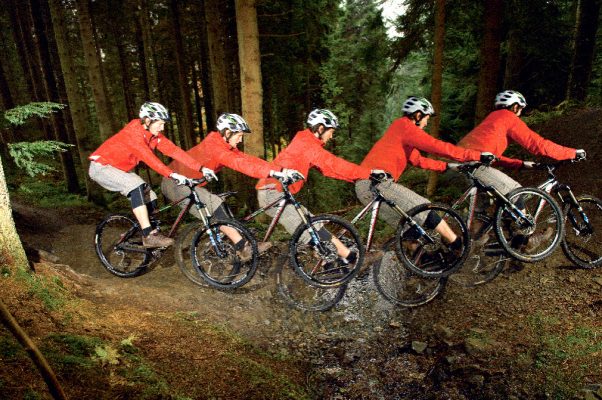How to loft the front of the bike.
Top coach Chris Ball shows you how to loft the front of the bike when crossing a shallow ditch or stream.
>>> The best mountain bike mud tyres
Winter in the UK means wet trails, deep puddles and cold, damp socks. With rivers over-flowing and little streams popping up everywhere, this is as good a time as ever to learn how to keep your speed and confidence when approaching waterlogged sections.
Little ditches, streams or even deep puddles and thick mud, can kill the flow of a good descent, forcing you to slow right down, go on some crazy detour or get really wet feet. None of which make for much fun.
The next few steps will show you the basics on how to negotiate these little speed-sucking obstructions. This is a great skill to learn but it takes practice so it’s worth finding a shallow ditch, with no trees or obstacles around, where you can hone your technique.
Heads up
When riding in the winter, it can be really useful to look far down the trail. Further than you might think. Conditions can change very quickly and what was once a solid compression can quickly turn into a front wheel-grabbing bog.
It’s surprising how fast you can ride if you look ahead and keep on a straight line. Once you’ve spotted your ditch or stream don’t slow up. A bit of speed is your friend, compensating for the loss of speed the water causes.
Balance
Getting in balance before you start your movement is crucial. Try and aim to hit the stream square on. Line up as early as possible and try and get your weight central on the bike.
Think of forming a square by keeping your bars and shoulders and two arms parallel. That’ll help to make sure you’re not going to fire off in an unexpected direction when you hit the water.
Lead from the front
Use your body weight and not your strength to get the lift. Move from the hips and get your bum as far back as possible. Using this momentum, the front wheel should come up smoothly and controllably.
A good thing to aim for here is to try and lift the front wheel while keeping your elbows straight. Any bend means that it’s likely you’re still pulling on the handlebars.
The push
This is the hard part. If you’ve timed it right, you will be back far enough to keep the speed going when the back wheel hits the water and slows down. As the trail drops away from you, pre-empt this by pushing through your legs. Dropping your heels will help you do this.
Think of pushing forward rather than downwards — it’s as if you’re trying to force the back wheel to stay on terra firma.
The other side
Once the back wheel has been pushed into the compression, you now need to absorb the opposite bank. Just like the push, it’s all in the legs. This can feel really awkward to start off with. Once you get the timing right you’ll be able to absorb the impact of the upslope and hang on to that precious speed. As your legs bend, bring your hips forward again and concentrate on your balance for the next part of the trail.




